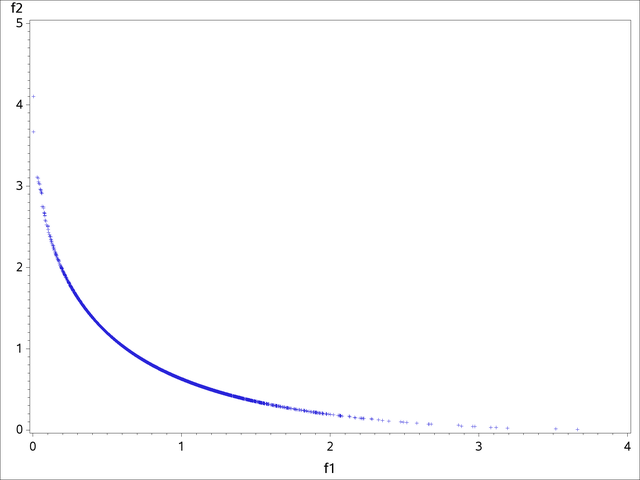The OPTLSO Procedure
- Overview
-
Getting Started

-
Syntax

-
Details
 The FCMP ProcedureThe Variable Data SetDescribing the Objective FunctionDescribing Linear ConstraintsDescribing Nonlinear ConstraintsThe OPTLSO AlgorithmMultiobjective OptimizationSpecifying and Returning Trial PointsFunction Value CachingIteration LogProcedure Termination MessagesODS TablesMacro Variable _OROPTLSO_
The FCMP ProcedureThe Variable Data SetDescribing the Objective FunctionDescribing Linear ConstraintsDescribing Nonlinear ConstraintsThe OPTLSO AlgorithmMultiobjective OptimizationSpecifying and Returning Trial PointsFunction Value CachingIteration LogProcedure Termination MessagesODS TablesMacro Variable _OROPTLSO_ -
Examples

- References
The following optimization problem is discussed in Huband et al. (2006); Custódio et al. (2011). This example illustrates how to use PROC FCMP to define multiple nonlinear objectives. This problem minimizes
subject to ![]() The VARIABLES=
VARDATA option in the PROC OPTLSO statement specifies the variables and their respective bounds. The objective functions are
defined by using PROC FCMP, and the objective function names and other properties are described in the SAS data set
The VARIABLES=
VARDATA option in the PROC OPTLSO statement specifies the variables and their respective bounds. The objective functions are
defined by using PROC FCMP, and the objective function names and other properties are described in the SAS data set objdata. The problem description is then passed to the OPTLSO procedure by using the options VARIABLES=
VARDATA and OBJECTIVE=
OBJDATA.
data vardata;
input _id_ $ _lb_ _ub_;
datalines;
x1 0 5
x2 0 5
;
proc fcmp outlib=sasuser.myfuncs.mypkg;
function fdef1(x1, x2);
return ((x1-1)**2 + (x1-x2)**2);
endsub;
function fdef2(x1, x2);
return ((x1-x2)**2 + (x2-3)**2);
endsub;
run;
data objdata;
input _id_ $ _function_ $ _sense_ $;
datalines;
f1 fdef1 min
f2 fdef2 min
;
options cmplib = sasuser.myfuncs; proc optlso primalout = solution variables = vardata objective = objdata logfreq = 50 ; run; proc transpose data=solution out=pareto label=_sol_ name=_sol_; by _sol_; var _value_; id _id_; run; proc gplot data=pareto; plot f2*f1; run; quit;
Output 3.10.1 shows the ODS tables that are produced.
Output 3.10.2 shows the iteration log.
Output 3.10.2: Multiobjective: Log
| NOTE: The OPTLSO procedure is executing in single-machine mode. |
| NOTE: The OPTLSO algorithm is using up to 4 threads. |
| NOTE: The problem has 2 variables (0 integer, 2 continuous). |
| NOTE: The problem has 0 constraints (0 linear, 0 nonlinear). |
| NOTE: The problem has 2 FCMP function definitions. |
| NOTE: The deterministic parallel mode is enabled. |
| Iteration Nondom Progress Infeasibility Evals Time |
| 1 7 . 0 84 0 |
| 51 962 0.000070835 0 2885 0 |
| 101 1689 0.000017074 0 5613 1 |
| 151 2289 0.000009575 0 8249 1 |
| 201 2933 0.000004561 0 10906 2 |
| 251 3429 0.000051118 0 13573 2 |
| 301 3876 0.000001452 0 16163 3 |
| 351 4386 0.000000716 0 18757 4 |
| 401 4796 0.000002728 0 21375 5 |
| 444 5000 0.000000698 0 23647 6 |
| NOTE: Function convergence criteria reached. |
| NOTE: There were 2 observations read from the data set WORK.VARDATA. |
| NOTE: There were 2 observations read from the data set WORK.OBJDATA. |
| NOTE: The data set WORK.SOLUTION has 25000 observations and 3 variables. |
When solving a multiobjective problem with 2 objectives, it can be useful to create a plot with PROC GPLOT of the Pareto-optimal set returned by PROC OPTLSO.
Output 3.10.3 shows a plot of the Pareto-optimal set found by PROC OPTLSO.
